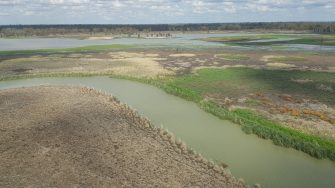
Date: Tuesday, November 6, 2018
Project: Eastern Australian Waterbird Survey
Observer: Richard Kingsford
We headed west from Sydney into a howling westerly, bringing the plane to a crawl at just over 100 knots in the face of a 50 knot headwind. Normally we survey at this speed but not when in transit. This was a big contrast to last week when we were doing double this speed on our way back from Mildura. The conditions today for aerial survey were looking grim with showers of rain sweeping in from the west. Not great. Surprisingly and with some relief, the showers disappeared for our count over Lake Cowal, our first wetland.
Lake Cowal from high up.
Down low – surveying Lake Cowal
Surveying the eastern edge of Lake Cowal
This was one of the few large wetland areas with water in the whole of eastern Australia, apart from the Lower Lakes and the Coorong. It didn’t disappoint with thousands of waterbirds, although I did think it would have more waterbirds, given how dry other places are this year. There were mainly grey teal, with some quite big flocks of pink-eared ducks, whiskered terns and a few black duck and hardhead. There were no breeding colonies of waterbirds. We flew the edge of the lake and then the middle, where there were large feeding flocks of pelicans.
Large flock of pelicans
Pelicans in a large feeding flock in the middle of Lake Cowal
The northern small lake of Nerang Cowal was dry, as were the other shallow wetlands to the north: Bogandillon Swamp and Banar Lake. The next wetland on our list was Lake Cargellico which was still pretty full. Even in the height of the dry times, there weren’t many waterbirds, apart from a few pelicans and cormorants. Lakes kept artificially full like this inevitably lose their productivity for waterbirds and other organisms.
Surveying Lake Cargellico
Then on to Lake Brewster which hardly had any water, except for along a channel and a recently flooded patch. Because it was so shallow, there were lots of waterbirds, most grey teal and pelicans.
Surveying along the channel of Lake Brewster
Flooded area and channel on Lake Brewster
Surveying flooded area on Lake Brewster
We then headed to Griffith to refuel and pick up another trainee observer. It is great to get such support from the states in terms of training up new observers for surveys in future years. It will certainly take the pressure off us so that we don’t have to spend a month and half in the plane, albeit being a great chance to see the rivers and count waterbirds.
After this we headed west to survey the Booligal system, an anabranch creek network of the Lachlan River. The Lachlan supplies this wetland system and the Great Cumbung Swamp, both magnificent wetlands of national and international importance, although not yet recognised. They have both been impacted by the building of dams upstream and extraction of water from the river. A potential plan to increase the size of Wyangala Dam by the NSW Government will only increase these impacts on these magnificent wetlands. It is not clear how such an initiative could be incorporated into the Murray-Darling Basin Plan because it will immediately change the shares of water and reduce the environmental share. There were only a couple of small wetland areas on the Merrimajeel and Merowie Creek systems, with reasonable numbers of waterbirds for their size.
Surveying one of the wetlands on Merrowie Creek
Merowie Creek system.
Surveying part of Merowie Creek with water
After tracking down these creek systems, we headed for the main stem of the Lachlan River. It flows into the Great Cumbung Swamp. Most of the associated wetland systems down here, on either side of where the Lachlan flows through the reedbeds of the Great Cumbung Swamp, were either dry or very shallow. As we flew over, you could see the carp with their backs out of the water reflecting the sun or swimming quickly through the water, disturbed by our plane. Not much in the way of waterbirds, a few of the usual grey teal, cormorants, and black duck. There were also a few small flocks of glossy ibis. When we got down to the bottom of the Great Cumbung Swamp, it looked as is if the water may be flowing with intricate patterns made from recent flooding. There were lots of grey kangaroos clustered around the remaining water and more than fifty feral pigs. These last remnants of water are a magnet for pigs in a dry landscape. We finished up in Swan Hill.
High overhead of the Great Cumbung Swamp
Surveying the Great Cumbung Swamp
Down low surveying the Great Cumbung Swamp
